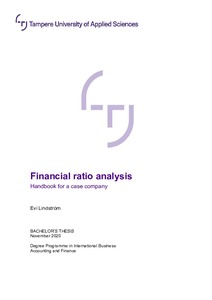Financial ratio analysis : handbook for a case company
Lindström, Evi (2020)
Lindström, Evi
2020
All rights reserved. This publication is copyrighted. You may download, display and print it for Your own personal use. Commercial use is prohibited.
Julkaisun pysyvä osoite on
https://urn.fi/URN:NBN:fi:amk-2020112724820
https://urn.fi/URN:NBN:fi:amk-2020112724820
Tiivistelmä
This thesis was commissioned by sole proprietorship who has operated in the field of beauty and wellness for eight years. The thesis topic was to establish a handbook and an Excel tool to assess the financial performance of the company. Financial ratios formed the backbone for the thesis since they are seen to be competent tools for financial analyzing. The handbook included theories about financial ratios and a financial ratio analysis of the case company’s three previous fiscal years. The Excel tool piloted the functional part of the thesis. Thesis purpose was to demonstrate how financial ratios and Excel models can be used in financial analyses.
To gain knowledge about financial ratios, the author familiarized herself with scientific literature as a secondary data. In financial ratio analysis the author used the commissioner’s financial statements, and the results were judged by using time series analysis and cross-sectional analysis. In cross-sectional analysis the author used beauty service and other health service industries’ median statistics from Finnvera. Therefore, the handbook was done by using secondary data and both quantitative and qualitative research methods. The Excel tool was made by following constructive research approach. From the theory, the author found out that financial ratio analyses require extensive framework and understanding large entireties. Based on the constructive research approach, the author found out that the Excel tool should be simple, easy to use and evoke new research questions.
From the financial ratio analysis, the author discovered that the case company’s strengths are that it generates enough profits from its core business activities and that the solvency of the company is adequate. High operational costs, dependence on customers and low levels of working capital are the company’s weaknesses. Author concluded that the case company can operate with this current strategy, but it does not necessarily secure long term survival.
From the financial ratio analysis, which was done with the Excel model, the author discovered a new research question: “how can the company improve its profitability?”. The author suggests that it should decrease its operational costs and ponder its pricing strategy again. Issues with profitability causes issues with other items as well which disturbs the total financial performance of the case company.
To gain knowledge about financial ratios, the author familiarized herself with scientific literature as a secondary data. In financial ratio analysis the author used the commissioner’s financial statements, and the results were judged by using time series analysis and cross-sectional analysis. In cross-sectional analysis the author used beauty service and other health service industries’ median statistics from Finnvera. Therefore, the handbook was done by using secondary data and both quantitative and qualitative research methods. The Excel tool was made by following constructive research approach. From the theory, the author found out that financial ratio analyses require extensive framework and understanding large entireties. Based on the constructive research approach, the author found out that the Excel tool should be simple, easy to use and evoke new research questions.
From the financial ratio analysis, the author discovered that the case company’s strengths are that it generates enough profits from its core business activities and that the solvency of the company is adequate. High operational costs, dependence on customers and low levels of working capital are the company’s weaknesses. Author concluded that the case company can operate with this current strategy, but it does not necessarily secure long term survival.
From the financial ratio analysis, which was done with the Excel model, the author discovered a new research question: “how can the company improve its profitability?”. The author suggests that it should decrease its operational costs and ponder its pricing strategy again. Issues with profitability causes issues with other items as well which disturbs the total financial performance of the case company.
